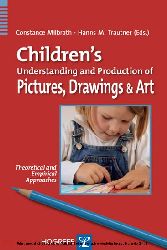Suchen und Finden
Foundations for symbolic understanding (p. 25-26)
In the precursor phase of symbolic development, core mechanisms develop and provide a foundation for understanding the symbolic relation between pictures and their referents. These include the intertwined mechanisms of perception and analogical reasoning, and the interwoven mechanisms of intentionality and imitation. The child must have certain abilities related to these mechanisms in place in order to appreciate the communicative intent of others when they use symbols. These include, 1) an appreciation of the unique perceptual relation between pictures and their referents (i.e., pictures are similar to, but differ from, their referents), 2) an understanding that pictures form a special category of artifacts in that they all have this same/different relational link between symbol and referent that goes beyond a perceptual similarity (i.e., pictures point to, but do not replace, the referent), 3) an ability to reason by analogy that all pictures, even novel ones, have this same/different relation to their referents, 4) an ability to understand the communicative intentions of others when they interact using pictures, and 5) an ability to imitate the intentional actions, and eventually the intentional stance, that others take toward pictures.
The perception of similarity and difference relations between 2-D pictures and their 3-D referents were explored in habituation and visual preference studies decades ago. The results in this area suggest that very early in life infants have impressive perceptual abilities that enable them to perceive similarities and differences between pictures and their referents, and to use this knowledge to form categories. At birth infants perceive differences between pictures and their referents (DeLoache, Strauss, &, Maynard, 1979, Dirks &, Gibson, 1977, Rose, 1977, Slater, Rose, &, Morison, 1984) and by 3 months they appreciate the similarity between the symbol and its referent (Rose, 1977). Infants also generalize across pictorial exemplars to form perceptual categories (Quinn &, Eimas, 1996), suggesting that pictorial symbols may provide important information to infants as they categorize the objects in their world. Quinn’s work provides evidence that infants can form even more complex categories based on spatial relations (Quinn, 1994). This suggests that during infancy the capacity to view pictures as a special kind of category, one that shares with other pictures the function of representation may be within reach. However, there have been no developmental studies that explore the formation of categories on the basis of representational relations.
Analogical reasoning may be required for such category building. Goswami (2001) argues that even very young infants engage in analogical reasoning that is perceptually based, and she proposes that they may build on these foundations to be able to reason about more complex relations during the preschool years. The ability to reason by analogy that novel pictorial symbols have a representational relation between the picture and its referent may be one such complex relation that comes within grasp during infancy and the early preschool years. Although many analogical reasoning studies employ pictorial symbols as stimuli, there are no studies that link the development of analogical reasoning ability to the onset of representational insight.
Alle Preise verstehen sich inklusive der gesetzlichen MwSt.









